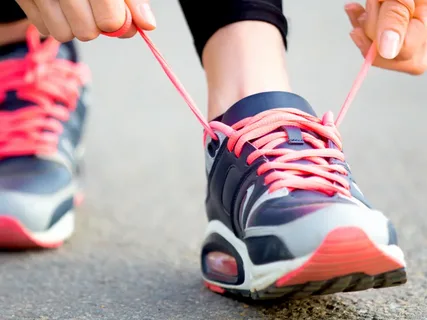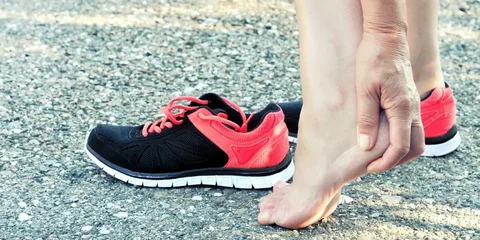If you’re a runner who suffers from heel spurs, it can be a painful and frustrating experience. Not only is running with heel spurs difficult, but it can also lead to further injury if not addressed properly. Fortunately, there are a variety of running shoes designed specifically to help runners with heel spurs get back to running pain-free. In that blog post, they will explore the best running shoes for heel spurs, so you can return to doing what you love as soon as possible.
Understanding Heel Spurs and Their Impact on Running
Heel spurs are a common foot condition that occurs when a bony growth develops on the underside of the heel bone. These growths are typically caused by repetitive stress or foot overuse, such as running. Heel spurs can cause significant pain and discomfort, especially when running or walking. For runners, the impact of heel spurs can be particularly troublesome. The constant pounding of the feet against hard surfaces can aggravate the condition and make running difficult and painful. It is essential to take care when choosing running shoes to ensure that they provide adequate support and cushioning to help prevent further injury.
Choose shoes that fit correctly
There are several key features in running shoes for heel spurs, including good arch support, a firm heel counter, and shock-absorbing technology. Additionally, it is essential to choose shoes that fit correctly to prevent rubbing and blisters. Stretching and support techniques can also help alleviate pain and improve mobility, allowing runners to return to their sport without discomfort. Ensure your shoes have a snug yet comfortable fit, with enough room in the toe box to allow for natural foot movement. By considering these key features when searching for the best shoes, you can find a pair that offers the necessary support, cushioning, and stability to keep you running pain-free.
Key Features of best shoes for heel spurs
When it comes to finding the best shoes for heel spurs, there are several key features that you should look for. These features can help provide the necessary support and cushioning to alleviate pain and discomfort caused by heel spurs. Firstly, it is important to look for shoes with excellent cushioning. Heel spurs can put added pressure on the heels, so having shoes with adequate cushioning can help absorb impact and reduce the strain on the affected area. Look for shoes with cushioned midsoles and heel pads.
Distribute weight evenly across the foot,
Next, consider shoes with good arch support. Proper arch support can help distribute weight evenly across the foot, reducing the stress on the heel and preventing further irritation. Look for shoes with built-in arch support or removable insoles that can accommodate orthotics if needed. Additionally, choose shoes with a wide and stable heel base. That can provide better stability and help prevent excessive pronation or supination, which can exacerbate heel spurs. Look for wider and flatter heel shoes to provide a more stable platform. Finally, selecting shoes with a comfortable and secure fit is crucial.
Choosing the Right Type of best shoes for heel spurs and achilles tendonitis
When dealing with heel spurs and Achilles tendonitis, choosing the right type of shoes that provide proper support and cushioning is crucial. Here are some factors to consider when selecting the best shoes for heel spurs and achilles tendonitis:
- Arch Support: Look for shoes with good arch support to help distribute weight evenly and reduce heel and Achilles tendon stress. A supportive shoe will help alleviate pain and prevent further injury.
- Cushioning: Opt for shoes with ample cushioning in the heel and midsole areas. That extra padding will absorb shock and provide a comfortable running experience, reducing the heel and Achilles tendon strain.
- Stability: Shoes with a stable design can help correct any overpronation issues that can aggravate heel spurs and Achilles tendonitis. For added stability, look for features like a firm heel counter and a structured midsole.
- Flexibility: Shoes that offer flexibility in the forefoot region allow for natural movement and help reduce strain on the Achilles tendon. Look for shoes with a flexible sole to ensure a smooth and comfortable running experience.
How to Properly Fit Your Running Shoes
Properly fitting your running shoes is essential for preventing further pain and damage to your heel spurs. When trying on shoes, it is important to ensure enough space in the toe box for your toes to move comfortably and that your heel is securely locked into the back of the shoe. Nadditionally, it is important to consider the width of the shoe. If you have wider feet, you may need to look for shoes that offer a wider fit. Conversely, if you have narrow feet, you may need to look for shoes with a narrower fit.
Shoes with a supportive insole
The arch support is another important factor to consider when fitting your running shoes. Many people with heel spurs benefit from shoes with ample arch support to reduce pressure on the heel. Look for shoes with a supportive insole or consider purchasing custom orthotics to help provide additional support. Lastly, it is important to ensure you have the correct size shoe. That may require you to measure your foot or visit a running shoe specialist who can help you find the best fit. Proper fitting shoes allow you to enjoy running pain-free and prevent further damage to your heel spurs.
The Importance of Proper Stretching and Support
When dealing with heel spurs, paying attention to the stretching and support your feet receive is crucial. Proper stretching helps reduce the tightness in your calves and plantar fascia, which can contribute to heel spurs’ formation. When you start running with heel spurs, you will need shoes that provide sufficient support and cushioning to reduce the pressure on your feet. The shoes you select should have features like a supportive arch, a soft cushioning, and good shock absorption. You must also ensure the shoes fit you perfectly and not cause discomfort or pain when running.
Stretching should be a part of your daily routine
Stretching is just as important as support. Stretching should be a part of your daily routine and should be performed before and after your workout. Stretches should include your calf muscles and plantar fascia, which can help reduce the tightness that often leads to heel spurs. You can also use massage balls or foam rollers to help release muscle tension. By focusing on stretching and support, you can reduce pain and discomfort associated with heel spurs. Don’t underestimate the importance of taking good care of your feet while running with heel spurs. Choose the right shoes and practice stretching to stay pain-free while still enjoying the sport.
Best shoes for heel spurs and plantar fasciitis
Plantar fasciitis is a common foot condition that often accompanies heel spurs. The plantar fascia is a thick band of tissue that connects the heel to the toes and helps support the foot’s arch. When that tissue becomes inflamed, it can cause pain and discomfort in the heel and bottom of the foot. When choosing the best shoes for heel spurs and plantar fasciitis, it is important to look for shoes that provide ample arch support and cushioning. The shoes should also have a firm heel counter to stabilize the heel and prevent excessive pronation, which can worsen the condition.
Alleviate the symptoms of heel spurs
It is also worth considering using orthotic inserts or custom-made orthotics to provide additional support and alleviate the symptoms of heel spurs and plantar fasciitis. Everyone is unique, and what works for one person may not work for another. It is essential to consult with a podiatrist or footwear specialist to find the best shoes that suit your specific needs and offer the necessary support for heel spurs and plantar fasciitis. Properly fitting your running shoes is equally important. Ensuring a proper fit will prevent rubbing and friction, which can exacerbate heel spurs. Take the time to measure your feet and try different shoe styles to find the perfect fit.
You can still enjoy that physical activity
While wearing the right shoes is crucial, it’s also important to incorporate proper stretching and support techniques into your routine. Regularly stretching your calf muscles and incorporating orthotic inserts can relieve and prevent further strain on your heel. Lastly, don’t let heel spurs discourage you from running. You can still enjoy that physical activity while managing the condition effectively with the right shoes, support, and techniques. Remember to listen to your body and make any necessary adjustments to your running routine. In summary, finding the best running shoes for the heel spurs is vital in your journey to pain-free running.
Conclusion
In conclusion, finding the best running shoes is crucial for returning to running pain-free. Heel spurs can be a frustrating and debilitating, but with the right footwear, you can alleviate the discomfort and continue pursuing your passion for running. When selecting the best shoes for the heel spurs, it’s important to consider key features such as cushioning, arch support, and stability. These factors will help absorb shock and provide the necessary support to prevent further strain on the affected area. Additionally, choosing shoes specifically designed for heel spurs and Achilles tendonitis can provide targeted support and relief.
| Other Good Articles to Read |
| Niche Blogs Connect |
| Blogs 97 |
| Blog Stitution |
| Blogs Cotch Rouge |
| Blog Signatr |
| Blog Sintonias |
| Blog Zilla |
| Consumer Forums |
| Finance Forums |
| G Blogs |
| Too Blog |



